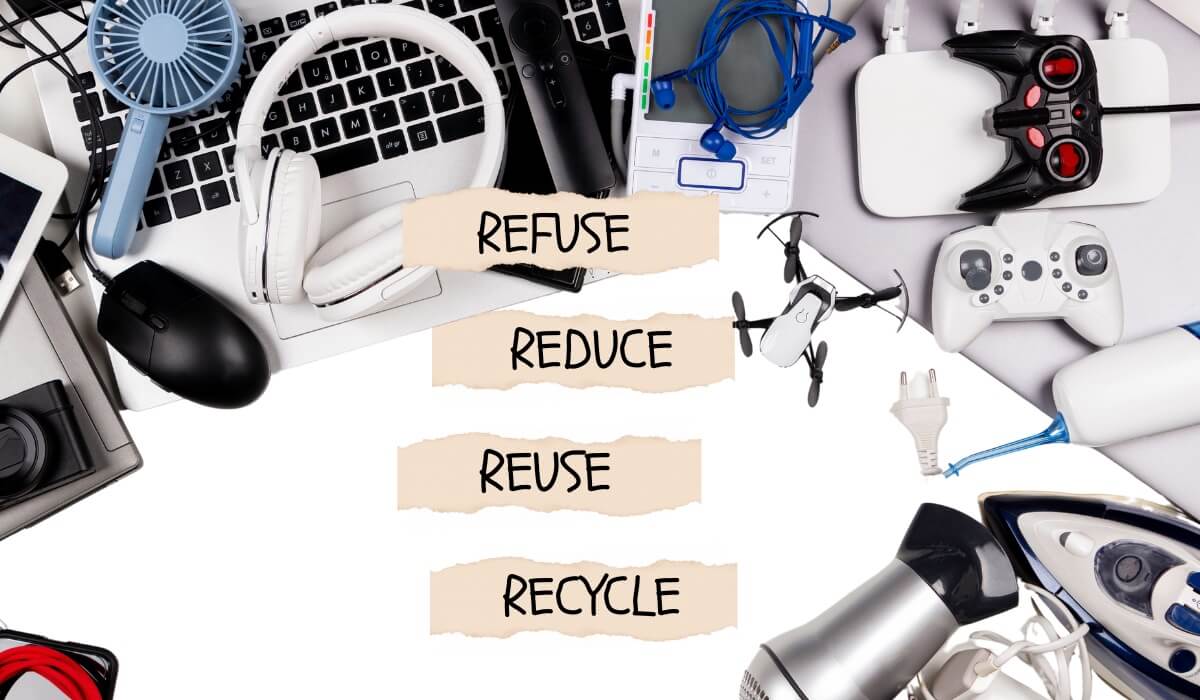The Hierarchy of the Re’s
You are probably familiar with the phrase “reduce, reuse, recycle.” You may have heard that it’s best to do things in that order. I suspect that you aren’t aware of starting with Refuse. As a verb, refuse means to say no to something. When individuals refuse to buy something, that saves all the resources and energy needed to make the item.
Refuse isn’t a popular term in the business world. That’s understandable. After all, if no one buys your products, you don’t have a viable business. I want to reframe Refuse. It applies when a company refuses to work with suppliers who don’t meet its Code of Conduct. It applies when the company refuses to design a new product without considering its environmental impact.
For situations where Refuse doesn’t apply, the next step is Reduce. How can you design products and source materials and components in a way that minimizes the consumption of energy, water, and raw materials?
Reuse is lower in the hierarchy of the Re’s than refuse or reduce. However, it is still vital to create a more circular economy with fewer kilograms of stuff going into landfills. There are multiple categories of reuse, and they have different impacts.
The longer something can be used without breaking it down into parts, the greater the value, and the more it can contribute to a circular economy. Sometimes, products can even be reborn.
Where Old Laptops Go to Die Be Reborn
Consider a laptop computer. After a few years, laptops tend to slow down. Certain functions no longer work as they once did, prompting owners (individuals or businesses) to turn them in for newer models. Where do used laptops go?
Often, old laptops languish in storage closets or, worse yet, go into landfills. Sometimes they go to e-waste recycling facilities. There are better options. One is to sell the old laptops to a refurbisher who will repair and upgrade them to resell. Tim Weedon, who appeared as a guest on the Sense and Sustainability podcast, is one such individual.
Tim Weedon is the CEO of RDUK, a Microsoft-authorized refurbisher in Kent, UK. RDUK buys used devices in bulk from companies that are upgrading their employees’ computers. His message is that laptops up to five years old are suitable for all but the most demanding uses after refurbishment, and customers can buy a used machine for one-third the cost of a new one while reducing the carbon footprint by 80 percent.
Tim says the trick is to do a thorough refurbishment job. DRUK’s process involves extensive testing and restoration. The result is a product that looks and functions as good as new, though Tim admits it can sometimes be hard to persuade customers of that.
Laptops should be kept in circulation as long as possible. However, they eventually become obsolete, often because they can’t run the latest operating system. Some parts, including entire printed circuit boards (PCBs), might still be usable. So might the chips on those boards even when the PCB no longer functions.
A Spin on Rework
Enter IC harvesting. The concept is simple and takes rework to a new level. Instead of removing and replacing a defective chip, harvesting removes a functioning IC from a defective or obsolete board and reattaches it to a new one. The larger the chip, the greater the potential savings in greenhouse gas emissions from reusing it.
While IC extraction has been commonplace in China for years and is a mature market there, the US market is just getting started. NIST is funding an effort to test the economic feasibility of a domestic chip harvesting program. The project, led by consultancy Earth Shift Global, runs through September 2024 and will be releasing two white papers later this year.
Global contract manufacturers are entering this industry segment. In 2023, Jabil acquired Retronix, a Scottish company specializing in re-balling packaged ICs. The acquisition supports Jabil’s Circular Economy Solutions efforts. However, the company notes a lack of industry-wide collaboration on IC recovery.
There are significant concerns about the reliability of these reused chips. Applying best practices from rework standards can reduce reliability risks. Traceability is critical. The companies doing the harvesting can mark components so that customers know whether a chip has been reused and how many times. The removal method also matters as it affects thermal history and exposure to mechanical stresses. Customers will want to know how the harvesting process will affect future performance.
Despite the obstacles, chip harvesting is an approach worth considering as OEMs and their suppliers look for ways to meet their circularity goals. It will be interesting to see what the NIST project concludes




















